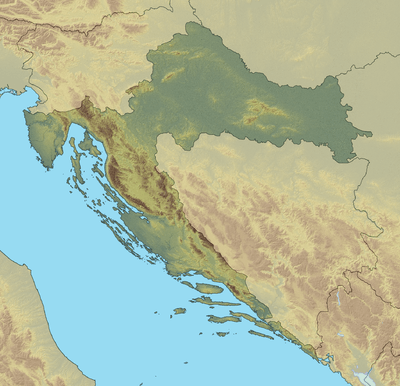Battle of Hrastovica
The Battle of Hrastovica (Croatian: Bitka kod Hrastovice) was an unsuccessful Ottoman raid into Croatia led by Malkoč-beg, Beylerbey of Bosnia Eyalet. The battle was a part of the Croatian–Ottoman wars and Ottoman–Habsburg wars between the Ottoman Empire and the Habsburg Monarchy.
| Battle of Hrastovica | |||||||
|---|---|---|---|---|---|---|---|
| Part of the Ottoman wars in Europe Ottoman–Croatian Wars | |||||||
| |||||||
| Belligerents | |||||||
|
|
| ||||||
| Commanders and leaders | |||||||
| Malkoč-beg of Bosnia Eyalet | Local castellan | ||||||
| Strength | |||||||
| Few thousands of akinji | Up to 120 soldiers and some armed serfs[1] | ||||||
| Casualties and losses | |||||||
| Light | Light | ||||||
Prelude
Hrastovica (now a village near Petrinja) was a fortified market-town and a property of Bishop of Zagreb in Middle Ages. Due to Ottoman raids, the market-town was fortified with a wall and two castles (the Upper and the Lower Castle), manned by two castellans with their crew. After the first Ottoman raids into Banija, in the middle of 16th century, Hrastovica was reinforced with two watchtowers on adjacent hills, and became an important post in the Military Frontier, and a seat of Hrastovica captaincy (regional military command).[1]
Battle

According to the chronicle of Nikola Tomašić, the forces of Malkoč-beg, Beylerbey of Bosnia were defeated near Hrastovica in 1561. The Ottoman raiders were defeated by local serfs and the minor garrison from the fort.[1]
Aftermath
Beylerbey of Bosnia Ferhad-bey Sokolović unsuccessfully attacked Hrastovica in 1576 with 7,000 men. In 1577 the fort had had a captain, a governor, 20 German mercenaries and 100 uskoks. After the fortress of Karlovac was built, Hrastovica lost its military importance, so in 1582 the Lower Castle was slated and the inhabitants were resettled in Turopolje in 1583. Hasan Pasha Predojević conquered Hrastovica in 1592; in 1594 and 1595. it changed hands several times, but was finally liberated from the Ottomans together with Petrinja, who took on its former military role.[1]
Bibliography
- Vojna enciklopedija (1970–76), 10 volumes, Vojno izdavački zavod Beograd, book 3, p. 498, article Hrastovica (in Serbo-Croatian)
References
- Gažević, Nikola (1974). Vojna enciklopedija (tom 3). Beograd: Vojnoizdavački zavod. p. 498.


